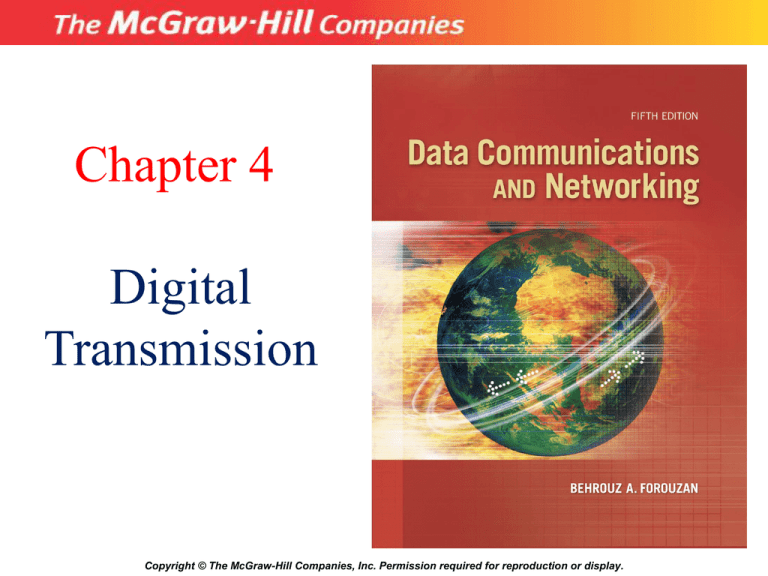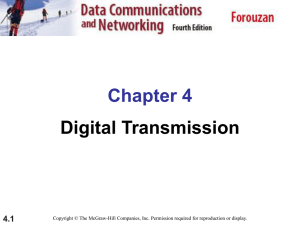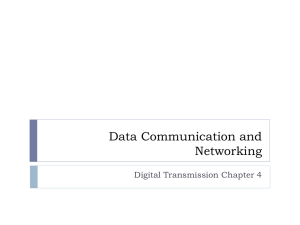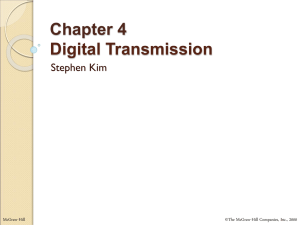Chap 4
advertisement

Chapter 4 Digital Transmission Copyright © The McGraw-Hill Companies, Inc. Permission required for reproduction or display. Chapter 4: Outline 4.1 DIGITAL-TO-DIGITAL CONVERSION 4.2 ANALOG-TO-DIGITAL CONVERSION 4.1 TRANSMISSION MODES 4-1 DIGITAL-TO-DIGITAL CONVERSION In this section, we explore how digital data is represented using digital signals. 4.3 4-1 DIGITAL-TO-DIGITAL CONVERSION The conversion involves three techniques: • line coding, • block coding, and • scrambling. 4.4 4-1 DIGITAL-TO-DIGITAL CONVERSION Line coding is always needed; block coding and scrambling may or may not be needed. 4.5 4.4.1 Line Coding Line coding converts a sequence of bits to a digital signal. • At the sender, digital data are encoded into a digital signal • At the receiver, the digital data are recreated by decoding the digital signal. 4.6 Figure 4.1: Line coding and decoding 4.7 4.4.1 Line Coding Define the ratio of data elements to signal elements with r = (data elements) / (signal elements). 4.8 Figure 4.2: Signal elements versus data elements 4.9 4.4.1 Line Coding Let S be the number of signals per second. This is baud rate. The relationship between bandwidth, N-bps, and baud rate, S-signals/sec, is: S = c * N * 1/r The value c is a unit-less value: 0 < c <=1 4.10 Example 4.1 A signal is carrying data in which one data element is encoded as one signal element (r = 1). If the bit rate is 100 kbps, what is the average value of the baud rate if c is ½ (the average value between 0 and 1)? 4.11 Example 4.1 A signal is carrying data in which one data element is encoded as one signal element (r = 1). If the bit rate is 100 kbps, what is the average value of the baud rate if c is ½ ? Solution The baud rate is then 4.12 Example 4.2 The maximum data rate of a channel (see Chapter 3) is Nmax = 2 × B × log2 L (defined by the Nyquist formula). Does this agree with the previous formula for Nmax? 4.13 Example 4.2 The maximum data rate of a channel (see Chapter 3) is Nmax = 2 × B × log2 L (defined by the Nyquist formula). Does this agree with the previous formula for Nmax? S = ½ N / r solve for N, N=2Sr 4.14 Digital Transmission Factors impacting Digital Transmission coding: 1. Synchronization 2. Baseline wandering 3. DC Components Synchronization If the clocks between the sender and receiver are not perfectly synchronized, there will be errors (too many or too few bits at the receiver). We need a way to synchronize the signal between sender and receiver. Baseline Wandering The average power is computed at the receiver and compared to ground. This difference is used to measure the relative voltage of incoming signals. Large changes in average power will result in errors when attempting to detect the incoming voltage. DC Components Not all channels can carry low frequency information. DC components will lead to errors when converting the signal elements back into data elements. Figure 4.3: Synchronization 4.19 Example 4.3 In a digital transmission, the receiver clock is 0.1 percent faster than the sender clock. How many extra bits per second does the receiver receive if the data rate is 1 kbps? 4.20 Example 4.3 In a digital transmission, the receiver clock is 0.1 percent faster than the sender clock. How many extra bits per second does the receiver receive if the data rate is 1 kbps? 0.1% is .001 Total bits received = (1 + .001)*1000 bits/sec Total bits received = 1001 (one extra bit). 4.21 Example 4.3 In a digital transmission, the receiver clock is 0.1 percent faster than the sender clock. How many extra bits per second does the receiver receive if the data rate is 1 kbps? Solution At 1 kbps, the receiver receives 1001 bps instead of 1000 bps. 4.22 4.4.2 Line Coding Schemes We can roughly divide line coding schemes into five broad categories, as shown in Figure 4.4. . 4.23 Figure 4.4: Line coding scheme 4.24 Figure 4.5: Unipolar NRZ scheme 4.25 Unipolar Not a good choice because if long streams of 1s occur, we get DC components and baseline wandering. Figure 4.6: Polar schemes (NRZ-L and NRZ-I) 4.27 Unipolar: NRZ-L Long streams of zeros or ones will cause DC components and baseline wandering. Unipolar: NRZ-I Long streams of ones are OK, but streams of zeros introduce DC components and baseline wandering. Example 4.4 A system is using NRZ-I to transfer 10-Mbps data. What are the signal rate and bandwidth? Case factor c = ½ 4.30 Example 4.4 A system is using NRZ-I to transfer 10-Mbps data. What are the signal rate and bandwidth? Case factor c = ½ NRZ-I has r = 1 (1 bit / signal) S=cN/r 4.31 Example 4.4 A system is using NRZ-I to transfer 1-Mbps data. What are the signal rate and bandwidth? Case factor c = ½ NRZ-I has r = 1 (1 bit / signal) S=cN/r S = ½ (1Mbps) / 1 = .5 Mbaud = 500 Kbaud 4.32 Example 4.4 A system is using NRZ-I to transfer 1-Mbps data. What are the signal rate and bandwidth? r = log2(L) N = 2 B log2( L) solve for B B=½N/r B = 1Mbps/2 = .5 MHz = 500 KHz 4.33 Figure 4.7: Polar schemes (RZ) 4.34 Polar Line Coding No DC components, no baseline wandering. These require 2 signal elements per data element (more bandwidth requirement) Figure 4.8: Polar biphase 4.36 Bipolar Bipolar – positive and negative amplitudes above and below the time axis. • AMI • Pseudoternary AMI Alternate Mark Inversion Every other 1-bit has a 180 degree phase change The 0-bit has zero amplitude Used for some long distance communications. Pseudoternary “three” states: 0-bits alternate phase 1-bits have zero amplitude Figure 4.9: Bipolar schemes: AMI and pseudoternary 4.40 Multilevel Schemes The goal is to send more bits per signal. We designate the different schemes by this notation: mBnL m = number of bits per signal element B = two possible data elements (0 or 1) binary L = number of levels Multilevel Schemes The goal is to send more bits per signal. We designate the different schemes by this notation: mBnL B^m <= L^n mBnL Schemes Example: 2B1Q (used for DSL) 2=2 B=2 n=1 L=4 (Q is for quad) Figure 4.10: Multilevel: 2B1Q (the diagram is wrong!) 4.44 8B6T 2^8 <= 3^6, 256 <= 729 this is the early line-code implementation of fast-Ethernet. 8B6T Bit patterns are weighted as 0 (neutral) or +1. If there are two consecutive +1 weighted bit patterns, the second one is inverted. This maintains DC balance. Figure 4.11: Multilevel: 8B6T (early version of fast Ethernet) 4.47 4D-PAM5 A different category of multilevel line coding: 4-dimensional 5-level pulse amplitude modulation. 4D-PAM5 Four wires transmit in parallel using 8B4Q over each wire. This is used for Gigabit Ethernet. Figure 4.12: Multilevel: 4D-PAMS scheme 4.50 Table 4.1: Summary of line coding schemes 4.51 4.4.3 Block Coding We need redundancy to ensure synchronization and to provide some kind of inherent error detecting. Block coding can give us this redundancy and improve the performance of line coding. In general, block coding changes a block of m bits into a block of n bits, where n is larger than m. Block coding is referred to as an mB/nB encoding technique. 4.52 Figure 4.14: Block coding concept 4.53 Figure 4.15: Using block coding 4B/5B with NRZ-I line coding scheme 4.54 Table 4.2: 4B/5B mapping codes 4.55 Block Coding nB/mB Coding 2^n bits as 2^m bits, m > n. Figure 4.16: Substitution in 4B/5B block coding 4.57 Example 4.5 We need to send data at a 1-Mbps rate. What is the minimum required bandwidth, using 1. a combination of 4B/5B and NRZ-I; or 2. Manchester coding? C = ½ for both 4.58 Example 4.5 We need to send data at a 1-Mbps rate. What is the minimum required bandwidth, using 1. a combination of 4B/5B and NRZ-I; or 2. Manchester coding C = ½ for both cases There is a 25% increase in bits due to the overhead in case-1 The link must therefore support a 1.25 Mbps rate to move 1-Mbps data. 4.59 Example 4.5 We need to send data at a 1-Mbps rate. What is the minimum required bandwidth, using 1. a combination of 4B/5B and NRZ-I; or, 2. Manchester coding NRZ-I encodes one bit per signal, r = 1. Manchester encoding encodes one bit per two signals: r = ½ 4.60 Example 4.5 We need to send data at a 1-Mbps rate. What is the minimum required bandwidth, using 1. a combination of 4B/5B and NRZ-I; or, 2. Manchester coding? C = ½ for both cases. B=cN/r NRZ-I : B = ½ (1.25Mbps) / 1 = 626KHz Man : B = ½ ( 1 Mbps) / .5 = 1. MHz 4.61 Figure 4.17: 8B/10B block encoding 4.62 4.4.4 Scrambling We modify line and block coding to include scrambling. 4.63 4.4.4 Scrambling The system inserts the required pulses based on the defined scrambling rules. Two common scrambling techniques are B8ZS and HDB3. 4.64 Figure 4.18: AMI used with scrambling 4.65 Figure 4.19: Two cases of B8ZS scrambling technique 4.66 4-2 ANALOG-TO-DIGITAL CONVERSION The techniques described in Section 4.1 convert digital data to digital signals. Sometimes, however, we have an analog signal such as one created by a microphone or camera. We have seen in Chapter 3 that a digital signal is superior to an analog signal. The tendency today is to change an analog signal to digital data. In this section we describe two techniques, pulse code modulation and delta modulation. 4.67 4.2.1 Pulse Code Modulation (PCM) The most common technique to change an analog signal to digital data (digitization) is called pulse code modulation (PCM). A PCM encoder has three processes, as shown in Figure 4.24. 4.68 Figure 4.21: Components of PCM encoder 4.69 Figure 4.22: Three different sampling methods for PCM 4.70 Figure 4.23: Nyquist sampling rate for low-pass and bandpass signals 4.71 Figure 4.24: Recovery of a sine wave with different sampling rates. 4.72 Example 4.9 Telephone companies digitize voice by assuming a maximum frequency of 4000 Hz. The sampling rate therefore is 8000 samples per second. 4.73 Example 4.10 A complex low-pass signal has a bandwidth of 200 kHz. What is the minimum sampling rate for this signal? Solution The bandwidth of a low-pass signal is between 0 and f, where f is the maximum frequency in the signal. Therefore, we can sample this signal at 2 times the highest frequency (200 kHz). The sampling rate is therefore 400,000 samples per second. 4.74 Example 4.11 A complex bandpass signal has a bandwidth of 200 kHz. What is the minimum sampling rate for this signal? Solution We cannot find the minimum sampling rate in this case because we do not know where the bandwidth starts or ends. We do not know the maximum frequency in the signal. 4.75 Figure 4.26: Quantization and encoding of a sampled signal 4.76 SNR based on sample size SNR(dB) = 6.02 n + 1.76. 4.77 Example 4.12 What is the SNRdB in the example of Figure 4.26? Solution We can use the formula to find the quantization. We have eight levels and 3 bits per sample, so SNRdB = 6.02(3) + 4.76 = 19.82 dB. Increasing the number of levels increases the SNR. 4.78 Example 4.13 A telephone subscriber line must have an SNRdB above 40. What is the minimum number of bits per sample? Solution We can calculate the number of bits as Telephone companies usually assign 7 or 8 bits per sample. 4.79 Example 4.14 We want to digitize the human voice. What is the bit rate, assuming 8 bits per sample? Solution The human voice normally contains frequencies from 0 to 4000 Hz. So the sampling rate and bit rate are calculated as follows: 4.80 Example 4.15 Transmitting a digital signal using n-bit samples requires: B(transmission) = sample size in bits *Bandwidth of signal What bandwidth is required to transmit a digital phone call? (4KHz, 8bits per sample). 4.81 4-3 TRANSMISSION MODES Of primary concern when we are considering the transmission of data from one device to another is the wiring, and of primary concern when we are considering the wiring is the data stream. Do we send 1 bit at a time; or do we group bits into larger groups and, if so, how? The transmission of binary data across a link can be accomplished in either parallel or serial mode. and isochronous (see Figure 4.31). 4.82 Figure 4.31: Data transmission modes 4.83 4.3.1 Parallel Transmission Line coding is the process of converting digital data to digital signals. We assume that data, in the form of text, numbers, graphical images, audio, or video, are stored in computer memory as sequences of bits (see Chapter 1). Line coding converts a sequence of bits to a digital signal. At the sender, digital data are encoded into a digital signal; at the receiver, the digital data are recreated by decoding the digital signal. Figure 4.1 shows the process. 4.84 Figure 4.32: Parallel transmission 4.85 4.3.2 Serial Transmission In serial transmission one bit follows another, so we need only one communication channel rather than n to transmit data between two communicating devices (see Figure 4.33).. 4.86 Figure 4.33: Serial transmission 4.87 Figure 4.34: Asynchronous transmission 4.88 Figure 4.35: Synchronous transmission Direction of flow 11110111 4.89 Frame 11111011 11110110 Frame ••• Frame 11110111 11110011







